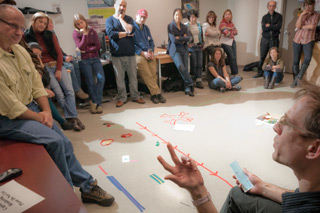New media changing oral history

History professor Steven High is part of a team ideally suited to produce the Oral Historian’s Digital Toolbox.
High, who holds the Canada Research Chair in Public History, helped to establish Concordia's Centre for Oral History and Digital Storytelling (COHDS) that has given dozens of individuals and organizations from across Canada access to the training, expertise and tools needed to help them conduct their own oral history projects.
High has also worked with a team of affiliates to develop Stories Matter, open-source software designed to help people organize and analyze digitized interviews and supporting materials.
“What we do has changed even in the five years since we started this,” says High, reflecting on the practices that have been developed since the COHDS opened its doors.
The Oral Historian’s Digital Toolbox, released in December 2010, was one of 20 projects across the country indentifying how digital technologies have changed knowledge production. High led a group of researchers and students affiliated with COHDS, including Stacey Zembrzycki, Jessica Mills and Laurel Hart, on the four-month project, which was funded through the Social Sciences and Humanities Research Council’s Knowledge Synthesis on the Digital Economy grant competition. In keeping with the “new technologies” theme of the project, the group used Google Docs to write their 75-page report, Telling Our Stories/Animating Our Past: A Status Report on Oral History and New Media.
The endeavour involved interviewing 16 leading oral historians around the world, visiting facilities with established expertise in the field and inviting three oral history researchers to Concordia for workshops and discussions. The tool box incorporates reviews of over 90 different software applications, used across many disciplines, that could be valuable for oral historians.

High says one major change identified in the report is the growing importance of geolocation tools that allow people to search data visually by place, as well as alphabetically or by subject. Whereas interviews were previously accessible through databases, they can now be tagged to maps. “It gets really exciting: You can see interview clips across a map or view the material different ways,” he explains.
The growing capacities of smartphone apps mean more possibilities for individually tailored audio tours. Mills has been developing a project on Pointe Saint-Charles, the industrial neighbourhood just south of the Lachine Canal. High points to the current possibilities of mapping software for projects like Mills’. “You can use the built environment as your canvas,” he explains. “So you could have anglophones and francophones create different tours of the neighbourhood and then do each other’s tours. You would end up with different readings of the same event, or identifying different points of interest.”
The application of geographic software to history-based projects is also indicative of a blurring of disciplinary boundaries facilitated by new media. The Life Stories project, for instance, involves professors from multiple Faculties and disciplines. “I probably work more now with theatre and communications researchers than I do with those in my own field,” says High. The research report also allowed High to become familiar with different technologies. “Every discipline has its own tool kit,” he says, adding for example, “NVivo (software that helps organize multimedia data) is heavily used in anthropology, and we didn’t know anything about it.” New media practices also have implications for student training and the definition of competencies. “Are students trained to author in sound?” asks High.

The report also considers the accessibility and utility of both open-source and proprietary software. High says the software he helped develop, Stories Matter, was created as an open-source tool and is currently employed by hundreds of researchers across the world. However, he sees potential problems with its sustainability. “We aren’t a business; we can’t maintain it that way,” he says. “So, down the line, if people have questions or problems, where do they go?” In addition to technological support, researchers need to consider the compatibility of programs and tools to ensure that the choices they make will work together in the long term. As formats and methods proliferate, archiving material and finding an ethical balance between accessibility and privacy become increasing preoccupations for those in the field.
Given the precariousness of community funds and the regular obsolescence of equipment and practices, the report suggests that it might be the role of the government to offer cloud computing, maintaining an infrastructure and making it available to organizations and projects whose own funding structures cannot sustain comparable levels of equipment maintenance and renewal.
Fundamentally, High’s question is, “How do you connect different publics?” The emergence of new interdisciplinary and community–university spaces of collaboration has been fostered by programs such as Canada Research Chairs and the Canadian Foundation for Innovation. High wonders whether this is a shortterm trend to move outside of disciplinary boundaries or if it represents “a reinvention of the university.”
Related links:
• The Oral Historian’s Digital Toolbox
• Steven High
• Memoryscapes Project
• Oral History resources at Concordia
• Social Sciences and Humanities Research Council Knowledge Synthesis grants